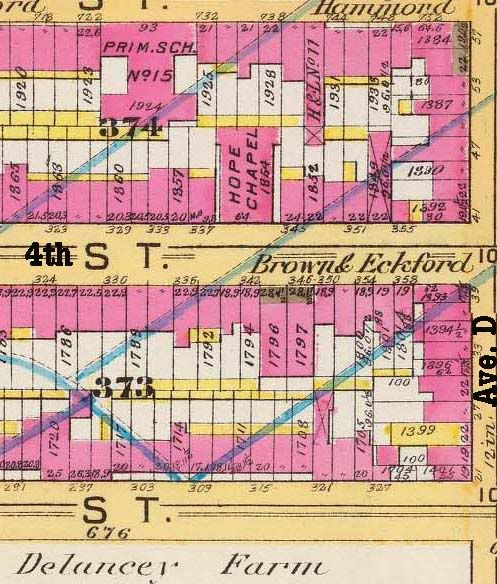
below, a map view of the block in 1891

This is something new to me About the Carpo Rusyns
Have you ever been asked the question: "What is your ethnic background?" Most of us have been asked this question many times, especially by fellow genealogists. We all have the ready answers: "I'm German; I'm English; I'm Irish; and on and on.
Yet, there are about one million descendants of an ethnically distinct people who came from the Carpathian Mountain region of the former Austro-Hungarian Empire who have a confused or non-existent sense of ethnic identity. These descendants of late 19th and early 20th century immigrants know that they are of Slavic ancestry, but are unsure to which specific ethnic group they belong to. This is understandable when you examine the origins and history of the Carpatho-Rusyns.
These people came from a specific geographic area with defined ethno-linguistic boundaries in the north east region of the former Austro-Hungarian empire. This area encompassed part of the then district of Galicia , the former old Hungarian counties of; Saros, Zemplen, Szepes, Abauj, Ung, Ugosca, Bereg and Maramos. These areas are now contained within the modern day boundaries of Poland, Slovakia, Ukraine and a few villages in Romania and Hungary . These immigrants originated in a small area of a very large empire. They did not come from a specific country. Furthermore, they were members of the Greek (Byzantine) Catholic Church (also called Uniate) and the Russian Orthodox Church, both of which were totally unfamiliar to native born Americans.
Their clergy were not required to be celibate. It was indeed a difficult thing for Americans to comprehend. Even the Roman Catholic bishops in the United States, in some cases, refused to believe that Catholic priests could be married! As you might imagine, this caused many an unpleasant incident when Eastern rite Catholic priests came to America and presented themselves to the local Roman Catholic bishop as per the custom. In some cases, communications between the two sides were strained to the point that Roman Catholic bishops refused to grant faculties to the Uniate priests. These priests were often insulted and angry because they were refused permission to exercise their religious rituals which were allowed by the Holy See and defected to Orthodoxy in many cases along with their congregation. This "conversion" required no change in their religious rituals.
Confusion extended to secular life as well and it was no small wonder then that the Rusyns did not know how to respond to their American friends and neighbors to the question: "What is your ethnic identity?" Some of the immigrants responded that they were Austrian or Hungarian because they were subjects of the Austro-Hungarian Empire. Some said they were Slovaks because they came from a village that was later incorporated into Czechoslovakia. Some said they were Ukrainian. These persons of Ukrainian national orientation came primarily from the eastern reaches of Galicia, the area east of the San River, where ethnic Ukrainians were numerous and very nationalistic. This Ukrainian identity was reinforced by the clergy and was instituted by Metropolitan Josyf Sembratovych. Some countered that they were Russians because they were members of the Russian Orthodox Church. The Orthodox priests reinforced this identity. This was a very confusing situation to say the least!
The immigrants within their own ethnic communities called themselves: Rusyn, Rusnak, Ruthene, Ruthenian, Carpatho-Russian, Carpatho-Ruthenian, Carpatho-Ukrainian, and Lemko. These terms have a religious connotation signifying membership in either the Greek Catholic or Russian Orthodox Church. Some of the immigrants and their offspring called themselves "Slavish" which is a slang term that they used meaning like "Slovak" - but not really! The Rusyns have a phrase in their language in which they refer to themselves as the "Po Nashomu" People. This in effect meant to them: people like us who speak our language. This was often a response to the question "Who are you?" Such an answer leads one to the conclusion that a nationalistic identity problem did exist, and still does, for this East Slavic group of people.


























No comments:
Post a Comment